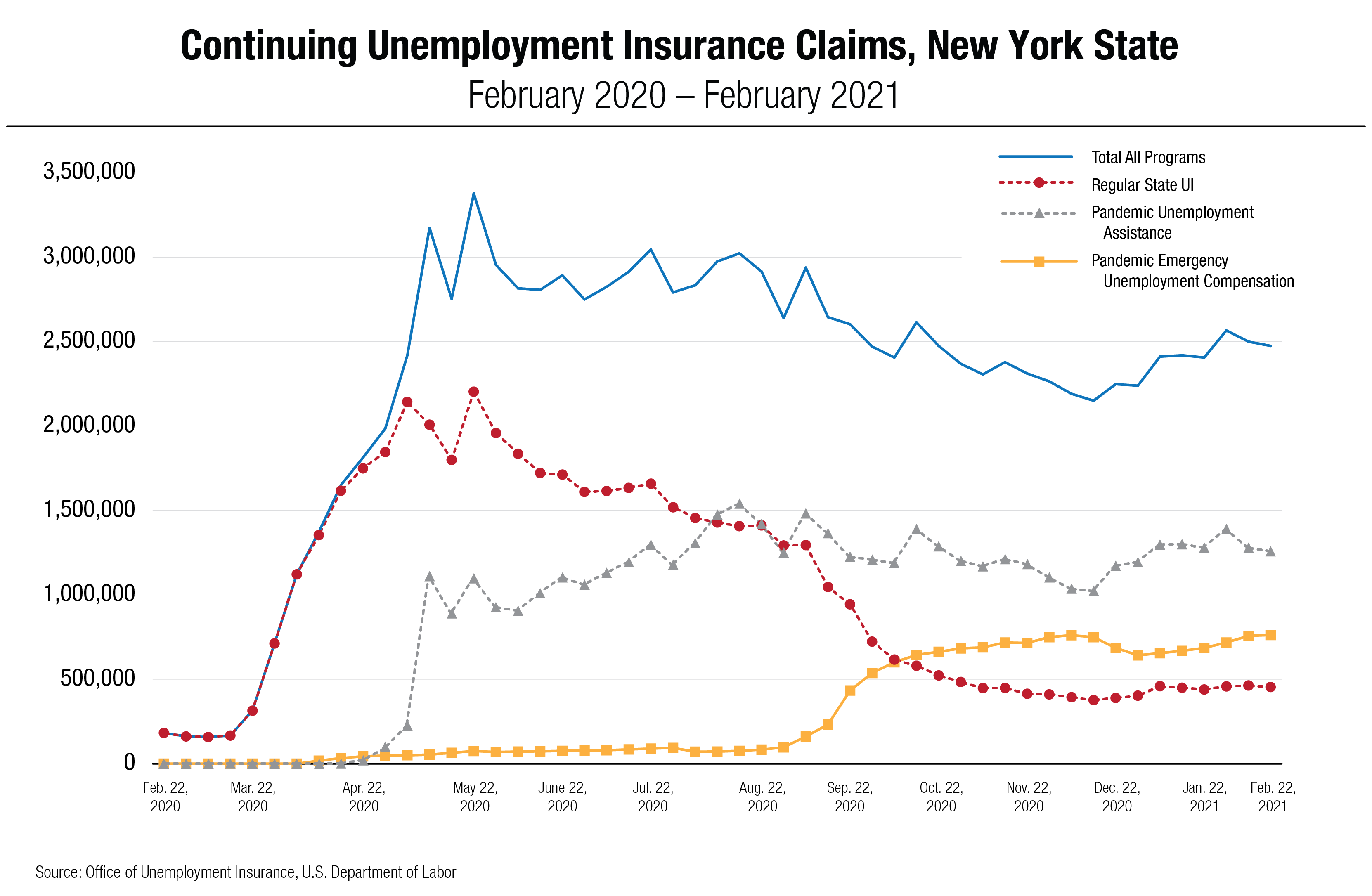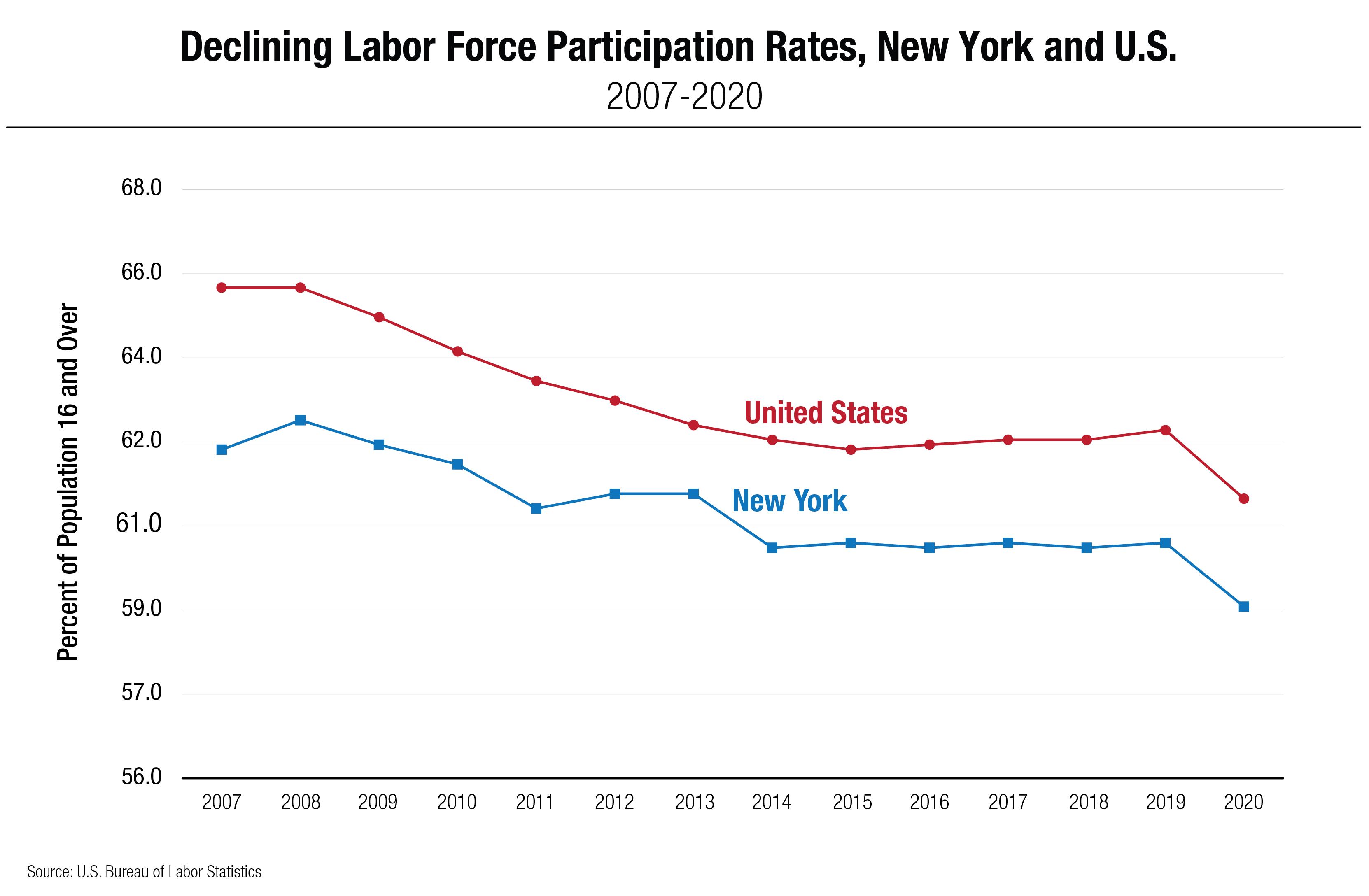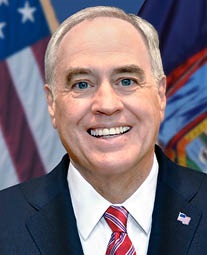New York’s Economy and Finances in the COVID-19 Era
March 4, 2021 Edition
Selected Economic Trends
New York Unemployment Claims Show a Year of Economic Devastation
A year after the first case of COVID-19 was reported in New York State, the economic disruption caused by the pandemic remains severe. One key measure is the total number of New Yorkers claiming unemployment insurance (UI) benefits. As shown in the top line of the graph below, the figure remains elevated 11 months after the initial surge of job losses, with 2.4 million claims reported by the U.S. Bureau of Labor Statistics as of mid-February 2021.
Immediately before the pandemic hit New York, for weeks ending in late February and early March 2020, statewide UI claims averaged around 167,000. Those claims almost doubled to over 314,000, as the shutdown went into effect, starting a weeks-long upward spike that reached more than 3.1 million in mid-May. The historic peak of nearly 3.4 million claimants came in the last week of May 2020. The totals from May onward include claimants under the Pandemic Unemployment Assistance program (PUA) which provides benefits to individuals not traditionally eligible for unemployment assistance because of self-employment or certain other reasons. (Due to the PUA and other factors, the numbers of workers claiming unemployment benefits differ from the count of those officially counted as unemployed, which peaked in New York State at 1.5 million or 15.9 percent of the labor force in July 2020.)
The longstanding, regular State program of UI benefits funded by employer contributions was the only source of benefits for the first six weeks shown in the graph and continued to fund the largest numbers of claims into early August. (These payments were supplemented by additional federally funded benefits of $600 or $300 weekly for much, though not all, of the period shown.)
Pandemic Emergency Unemployment Compensation (PEUC), which provides continuing support to workers whose benefits would otherwise expire, became increasingly important starting in September, and PEUC claims soon surpassed those made under the regular State program. PEUC and PUA are entirely federally funded as part of the extraordinary relief and stimulus actions taken by Congress and the President.
New York's Labor Force Participation at Lowest Point Since 1984
The proportion of working-age New Yorkers who are actively in the labor force — the labor force participation rate (LFPR) — fell below 60 percent in 2020, to its lowest level since 1984.
Those who are counted as being in the labor force include both employed individuals and those who do not currently have a job but are seeking one. Working-age individuals may be out of the labor force because they are stay-at-home parents, persons with disabilities, caregivers, or full-time students, among other reasons.
New York’s participation rate has lagged the nation’s for well over a decade. As shown in the figure above, both the national rate and New York’s LFPR had been stable for five years before the pandemic struck, and each declined by more than a percentage point over the past year.
As shown in a previous update, the declining number of individuals in the workforce has been a key factor in lower unemployment rates in recent months. Those who leave the workforce, particularly for extended periods, may experience long-term impacts on earnings. Women and minorities have been disproportionately affected by the recent trend of workers leaving the labor force.
Economists who analyze labor markets have pointed to an aging population and other factors as potential reasons for the longer-term decline in labor force participation. A 2017 report by the Office of the State Comptroller, Labor Force Trends in New York State, noted that continued shrinkage of the labor force could inhibit overall economic growth and contribute to budgetary challenges for the State and local governments.
Fiscal Developments – New York's State and Local Governments
Will Washington Provide Fiscal Relief for New York and Its Local Governments?
Potential budgetary relief for states and local government entities is among the key items being debated as the U.S. Congress and the Biden Administration negotiate the next federal relief and stimulus package in response to the COVID-19 pandemic.
Legislation passed by the House of Representatives on February 27 would provide $12.7 billion in unrestricted aid to New York State, according to the House Committee on Oversight and Reform, chaired by Representative Carolyn B. Maloney of New York. In addition, the bill includes an estimated $10.9 billion in budget relief for more than 1,000 local governments in New York, ranging from New York City to small towns and villages, according to the Committee. The City would receive an estimated $5.9 billion under the bill. These figures and those referenced below may change as a result of negotiations or other factors.
Among the largest counties outside New York City, the Committee estimates the following amounts of unrestricted aid would be distributed (see table below with estimates for all counties in New York State):
- Suffolk, $286 million;
- Nassau, $398 million;
- Westchester, $188 million; and
- Erie, $178 million.
- Estimated Allocations for Counties
-
County Allocation Albany County $59,251,007 Allegany County $8,939,066 Broome County $36,943,975 Cattaraugus County $14,762,423 Cayuga County $14,851,444 Chautauqua County $24,612,055 Chemung County $16,185,777 Chenango County $9,155,507 Clinton County $15,609,570 Columbia County $11,532,095 Cortland County $9,228,042 Delaware County $8,559,711 Dutchess County $57,061,769 Erie County $178,176,596 Essex County $7,153,619 Franklin County $9,701,459 Fulton County $10,353,304 Genesee County $11,109,103 Greene County $9,151,822 Hamilton County $856,456 Herkimer County $11,892,442 Jefferson County $21,301,628 Lewis County $5,099,947 Livingston County $12,201,783 Madison County $13,758,570 Monroe County $143,861,724 Montgomery County $9,546,110 Nassau County $397,704,320 Niagara County $40,588,761 Oneida County $44,349,332 Onondaga County $89,316,570 Ontario County $21,290,573 Orange County $74,656,743 Orleans County $7,826,022 Oswego County $22,715,479 Otsego County $11,538,301 Putnam County $19,068,559 Rensselaer County $30,781,603 Rockland County $63,184,770 Saratoga County $44,580,513 Schenectady County $30,119,285 Schoharie County $6,012,065 Schuyler County $3,453,558 Seneca County $6,597,194 St. Lawrence County $20,895,510 Steuben County $18,498,170 Suffolk County $286,377,671 Sullivan County $14,629,572 Tioga County $9,348,675 Tompkins County $19,817,182 Ulster County $34,439,190 Warren County $12,401,545 Washington County $11,870,139 Wayne County $17,439,042 Westchester County $187,641,831 Wyoming County $7,730,408 Yates County $4,831,723 Source: House Committee on Oversight and Reform
The Committee estimates that the City of Buffalo would receive $350 million under the House bill; Rochester, $207 million; Syracuse, $126 million; Yonkers, $89 million; and Albany, $85 million. Estimates for other larger cities and towns in New York appear in the table below.
- Estimated Allocations for Larger Cities and Towns
-
Municipality Allocation Albany $85,282,416 Amherst $15,533,802 Auburn $22,180,857 Babylon $27,248,859 Binghamton $48,316,814 Brookhaven Town $55,489,996 Buffalo $350,050,488 Cheektowaga $26,144,656 Colonie $8,883,979 Dunkirk $11,594,482 Elmira $30,830,515 Glens Falls $12,231,986 Greece $10,614,095 Hamburg $10,444,137 Huntington $21,611,929 Irondequoit $22,851,964 Islip $50,797,681 Ithaca $17,019,027 Jamestown $29,868,650 Kingston $18,662,668 Middletown $12,382,500 Mount Vernon $42,632,296 New Rochelle $36,186,060 Newburgh $21,759,826 Niagara Falls $59,477,053 Poughkeepsie $20,773,058 Rochester $206,828,044 Rome $25,939,899 Saratoga Springs $7,696,542 Schenectady $57,843,158 Syracuse $126,169,690 Tonawanda $42,406,749 Troy $45,598,010 Union $31,938,981 Utica $63,990,959 Watertown $22,953,022 White Plains $21,981,634 Yonkers $88,892,789 Source: House Committee on Oversight and Reform
The Committee also provides estimates for more than 950 smaller municipalities in New York State. A complete list of those estimates is available on the Committee website.
State's General Fund Balance Over $20 Billion
The State’s General Fund balance has been at historically high levels, over $19 billion, in recent weeks. The updated Executive Budget Financial Plan issued by the Division of the Budget (DOB) in mid-February projected that balance would be $20 billion at the end of February. As of February 26, the actual figure was $20.4 billion.
DOB has projected the State will end the current fiscal year on March 31 with a General Fund balance of $7.2 billion. Among other factors, that figure reflects the planned repayment of $3.4 billion in notes issued in 2020 for cash-flow purposes, and over $15 billion in local assistance payments estimated to be paid in March, including the release of not-yet-specified amounts previously withheld from municipalities, nonprofit organizations and other recipients. In addition, the updated Financial Plan indicates that $1.6 billion in debt service payments previously expected to be made in State fiscal years 2022-23 through 2024-25 will instead be made before the end of the current fiscal year. The end-of-year balance will also be affected by decisions on specific uses and timing of federal stimulus funds.
Comptroller DiNapoli Releases Analysis of Executive Budget
Comptroller DiNapoli said there are some positive developments for the State’s fiscal recovery from the pandemic, including higher than expected personal income tax collections and the prospect of significant aid from the federal government, in his review of the Executive Budget for State Fiscal Year 2021-22, as amended by the Governor. However, risks remain and could threaten the State’s fragile improvement. For the complete analysis, see the report.
Prior Editions
- February 18, 2021
- February 3, 2021
- January 21, 2021
- January 7, 2021
- December 16, 2020
- December 2, 2020
- November 12, 2020
- October 28, 2020
- October 14, 2020
- September 30, 2020
- September 16, 2020
- September 2, 2020
- August 19, 2020
- August 5, 2020
- July 22, 2020
- July 9, 2020
Additional Resources
- COVID-19 Financial Survival Toolkit
- State Cash Basis Reports
- Report on the State Fiscal Year 2020-21 Enacted Budget Financial Plan
- Report on the State Fiscal Year 2020-21 Enacted Budget: Budgeting in a Time of Crisis
Subscribe for Latest Updates
The State Comptroller’s Office is committed to keeping New Yorkers regularly updated on the State’s economy and finances. Subscribe to get the latest update.



